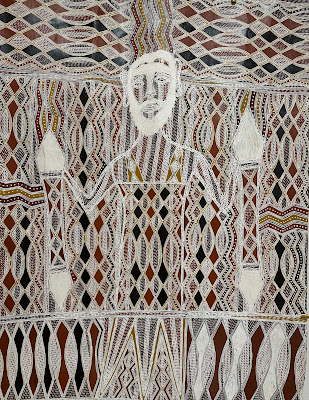Who knew Australian bark painting could be so beautifully abstract?
 |
"Yalanbara" by Dhuwarrwarr Marika (2019) |
The genre wasn't exactly new to me; I'd seen a comprehensive survey at the Art Gallery of New South Wales when I visited Sydney in 1983, before circumnavigating the country in a VW camper van with my father. Our route included every city marked on the map, including the two I'm obscuring, Adelaide and Alice Springs!
I even bought a small bark painting from a shop in the latter which obviously catered to the tourist trade with this simple kangaroo. It has hung between the bay windows at 47 Pianos ever since.
There was a long-forgotten provenance glued to the back. Although I couldn't quite make out the artist's name in the lower left corner, the typewritten information indicates he--most were men back them--belonged to the Gunwinggu tribe in the Oenpelli area.
We didn't get to Arnhem Land (the darkened area on the map above) where my painting and those now on view at the Asia Society originated. Many of the works in "Maḏayin: Eight Decades of Aboriginal Australian Bark Painting from Yirrkala are taller than I am.
 |
| "Sand Sculpture for Yirritja Mortuary Ceremonies" by Narritjin Maymuru (before 1972) |
 |
| "The Marawili Tree Ranga (The Possum String Story)" by Narritjin Maymuru (partial, 1968) |
A video installation emphasized the relationship between painting, singing and dancing in Aboriginal culture.
The earliest work in the show, painted by a tribal leader and his sons, dates back to a pivotal moment in the relationship between the Aboriginal tribes of Australia and its colonialist government.
The 1935 bark painting of sacred clan designs was among those given by Wongu Munungurr to Donald Thomson, an Australian anthropologist, who sought to improve relations with the tribe after the Caledon Bay crisis.
 |
| Wonggu Mununggurr by Donald Thomson (1935) |
For the most part, the earlier works in the exhibit appealed to me more than the later ones.
 |
"Gurrunawuy" by Yäma Munungirritj (1961) |
 |
| "Nalarrwuy" by Mungurrawuy Yunupinu (partial, 1961) |
Further complicating a naive viewer's comprehension of the art are the orthological differences conjured by the transcription of Australian Aboriginal languages which, until the arrival of colonists, had never been written. Look no further than the titles of the works and artists' names for evidence of this; the language uses just three vowels.
 |
| "Naypinya" by Mithinari Gurruwiwi (partial, 1963) |
 | ||||
| "Dhuwa Honey Ancestor" by Dundiwuy Wanambi (partial, 1994) |
 |
| "Dhalwanu Clan Designs" by Yinimala Gumana (2019) |
Another gallery included contemporary paintings influenced by Aboriginal art.
 |
| "Untitled (Alhalker)" by Emily Kam Kngwarray (close-up, 1993) |
 |
| "Rockholes Near the Olgas X" by Bill "Whiskey" Tjapaltjarri (2008) |
Dhambit Mununggurr, one of the contemporary Aboriginal artists in the show, abandons the use of traditional colors in her "bark blues."
 |
| "Ocean" (2019) |












No comments:
Post a Comment